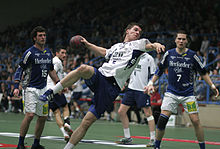Circle runner (handball)


A circle runner (also: circle player or circle center ) is a playing position or a player in handball . The circle runner is the player who is at the height of the 6-meter circle in his team's attack game, usually with his back to the goal and within the opposing defense.
Number of runners in the game
In a typical handball game with two full teams, the attackers play with a circle runner. Teams that are outnumbered, for example after a time penalty, often forego filling this position initially. If a team, for example in the final phase of a game, replaces its goalkeeper with a seventh field player, this player is usually used as a second runner.
During the game, after a few rallies, one of the players from the back area or from the outer positions often goes around the circle as a circle. This move is called running in or transition. However, these players are not really circular players.
Functions of the circuit
One of the most important tasks of a cyclist is to create gaps in the opposing defensive association for their own backcourt players. These can then get to the circle by throws from the back area or by breaking into these gaps and thus possibly score a goal. The gaps are opened by blocking individual opposing players.
Equal to this task, the circle runner has to free himself by blocking and releasing, in order to be able to be played by his teammates - mostly from the three backcourt positions. Depending on the defense system's coverage system, the main tasks of the circuit can vary significantly. In the case of opponents who are relatively offensively covering, the runner often leaves the defensive area in order to offer himself up for a pass and, for example, to bring his teammates into favorable throwing positions by means of a double passing game. Circular runners are usually in intensive contact with the opposing defense when attacking. The statement that handball is a body-hugging game is particularly evident in this position. Holding the circuit by the arms and hands or the jersey is not permitted, as is pushing, but it is often observed.
Like all attacking players, the circle runner must step out of the 9-meter zone during free throws. Often he then forms the block for one of the backcourt shooters, possibly together with one or two other players. For many teams, the circle runner is also responsible for executing the fast middle .
In principle, a cyclist can assume any position in cover. Since the runners in top teams are physically quite strong in most cases, they are rarely used in the outer positions ("wings") or as "advanced" (with a 5: 1 cover). These game positions are typically occupied by fast and lighter players.
Important properties of a circuit
The position of the circulator is the only game position in which a comparatively higher body weight is advantageous in order to be able to prevail against the opponents, especially when turning the ball towards the goal. A tall body length is an advantage against the defending wall at the circle. Throwing power is also very important in this position. High assertiveness and catch security are important. A good cyclist is also characterized by a sure sense of time for weaning and several throwing variants.
In principle, handedness does not play a role for a cyclist. Only the preferred direction of rotation with the ball towards the goal changes with the handedness. Left and right-handers can play in this position equally. However, since left-handers are preferred in the two right attack positions (right outside and right back) and the proportion of potential positions for left-handers (two out of six = 33%) is higher than the number of left-handers in the population (especially women), they become left-handed usually committed to these two positions in youth. Because of this, left-handed circulators are relatively rare. The most famous left-hander on the circle position was the Swede Per Carlén .
Well-known circular runners
- Ingolf Wiegert (born November 3, 1957)
- Per Carlén (born November 19, 1960)
- Magnus Wislander (born February 22, 1964)
- Ola Lindgren (born February 29, 1964)
- Mike Fuhrig (born April 17, 1965)
- Klaus-Dieter Petersen (born November 6, 1968)
- Andreas Rastner (born November 10, 1968)
- Christian Schwarzer (born October 23, 1969)
- Mark Dragunski (born December 22, 1970)
- Rolando Uríos (born January 27, 1971)
- Dmitri Nikolajewitsch Torgowanow (born January 5, 1972)
- Guéric Kervadec (born January 9, 1972)
- Armands Uščins (born October 6, 1973)
- Andrej Klimovets (born August 18, 1974)
- Artur Siódmiak (born October 7, 1975)
- Bertrand Gille (born March 24, 1978)
- Marcus Ahlm (born July 7, 1978)
- Oliver Roggisch (born August 25, 1978)
- Michael V. Knudsen (born September 4, 1978)
- Bartosz Jurecki (born January 31, 1979)
- Jens Tiedtke (born October 10, 1979)
- Frank Løke (born February 6, 1980)
- Róbert Gunnarsson (born May 22, 1980)
- Igor Vori (born September 20, 1980)
- Sebastian Preiß (born February 8, 1981)
- Matthias Flohr (born March 29, 1982)
- Bjarte Myrhol (born May 29, 1982)
- Julen Aguinagalde (born December 8, 1982)
- Cédric Sorhaindo (born June 7, 1984)
- Wiebke Kethorn (born August 10, 1985)
- Manuel Späth (born October 16, 1985)
- Jacob Heinl (born October 3, 1986)
- Patrick Wiencek (born March 22, 1989)
- Luisa Schulze (born September 14, 1990)
- Hendrik Pekeler (born July 2, 1991)
- Jannik Kohlbacher (born July 19, 1995)
Individual evidence
- ↑ handball-praxis.de lock-off , accessed on December 5, 2007 ( Memento from March 7, 2016 in the Internet Archive )
- ↑ Late D et al., Handball Handbuch , Philippka-Sportverlag, ISBN 3-89417-063-8





